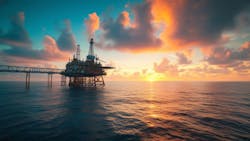Editor's note: This column first appeared in the January-February 2024 issue of Offshore magazine. Click here to view the full issue.
By David Paganie, Chief Editor
The offshore industry continues to benefit from strong demand for all sources of energy, driven by policy direction on energy security and energy transformation. Some international operators are responding by adjusting capex allocations in favor of oil and gas developments, while others are doubling down on renewable power from offshore wind. Either way, the low-breakeven cost/barrel of offshore oil and gas developments, favorable carbon intensity versus onshore projects, and strong wind resources are making offshore energy targets increasingly attractive to investors.
Regionally, Asia, led by China, will take the largest share of global capex this year for offshore wind; and offshore upstream oil and gas activity will be led by projects in the US Gulf of Mexico and offshore Brazil, Guyana, Saudi Arabia, and Norway. Read Rystad Energy's analysis, which states oil and gas capex will remain elevated, and even grow marginally.
A new area, offshore Cyprus, could be the anchor point of that nation’s first natural gas development. The project operator and Cypriot government are working toward agreement on the field development plan. Read the E&P analysis on the Eastern Mediterranean region.
The area of greatest opportunity this year for offshore contractors and suppliers is related to floating oil and gas platform construction. A recent survey by Energy Maritime Associates assessed industry sentiment in the market, opportunities, and challenges. Survey respondents expect busy times this year, particularly in the areas of tendering and project execution. Regarding platform type, FPSOs have the largest growth potential, and floating wind technology could have the greatest impact on the industry. But, despite a promising outlook, the market will be challenged by capacity constraints and access to finance. Read the complete survey results and market analysis.
Meanwhile, decarbonization approaches are providing additional opportunities for the traditional offshore contractors. One approach is carbon, capture, and storage (CCS). The need for well construction, maintenance and P&A work from offshore CCS is presenting new opportunities for drilling rig contractors and downhole service firms, according to Bruce Beaubouef, Offshore managing editor. In Northwest Europe, CCS projects and related P&A work are prompting new jackup rig demand in the region. Read Bruce’s full report on the growth in CCS projects and related drilling contractor work.
Another decarbonization approach, the use of low-emission hydrogen, is supporting the offshore workforce. Hydrogen produced with renewable or nuclear energy, or fossil fuels using carbon capture, is claimed to have potential to decarbonize a range of sectors. Hydrogen generated in this way is often referred to as green hydrogen. Pilot projects are under development, and early-phase small-scale hydrogen production facilities are being installed in the Dutch North Sea. In the meantime, one engineering firm has developed a concept for a large-scale green hydrogen facility, drawing on its experience in offshore high-voltage direct-current transmission and onshore electrolysers. Read a review of the concept.
All this growth in offshore infrastructure elevates the importance of ongoing innovation in above water and subsea robotics and vehicles for inspections and maintenance. And improvements in these technologies are adding impetus to increase the level of remote and autonomous operations. This month’s special report reviews the state of technology for offshore remote inspections and operations. Read the special report.



